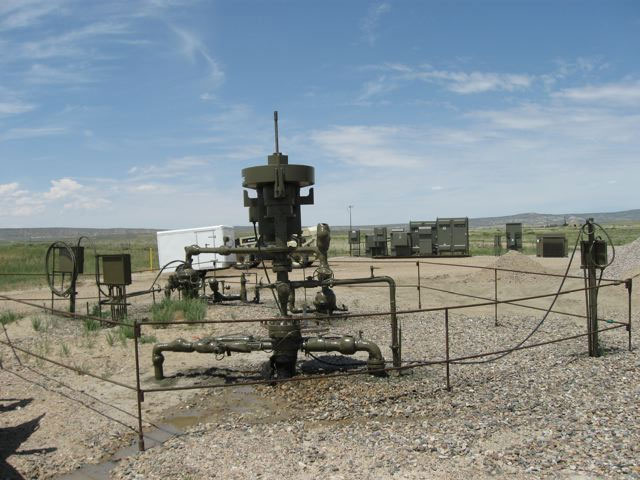
by Deep Green Resistance News Service | Sep 20, 2012 | Toxification
By Abrahm Lustgarten / ProPublica
On a cold, overcast afternoon in January 2003, two tanker trucks backed up to an injection well site in a pasture outside Rosharon, Texas. There, under a steel shed, they began to unload thousands of gallons of wastewater for burial deep beneath the earth.
The waste – the byproduct of oil and gas drilling – was described in regulatory documents as a benign mixture of salt and water. But as the liquid rushed from the trucks, it released a billowing vapor of far more volatile materials, including benzene and other flammable hydrocarbons.
The truck engines, left to idle by their drivers, sucked the fumes from the air, revving into a high-pitched whine. Before anyone could react, one of the trucks backfired, releasing a spark that ignited the invisible cloud.
Fifteen-foot-high flames enveloped the steel shed and tankers. Two workers died, and four were rushed to the hospital with burns over much of their bodies. A third worker died six weeks later.
What happened that day at Rosharon was the result of a significant breakdown in the nation’s efforts to regulate the handling of toxic waste, a ProPublica investigation shows.
The site at Rosharon is what is known as a “Class 2” well. Such wells are subject to looser rules and less scrutiny than others designed for hazardous materials. Had the chemicals the workers were disposing of that day come from a factory or a refinery, it would have been illegal to pour them into that well. But regulatory concessions won by the energy industry over the last three decades made it legal to dump similar substances into the Rosharon site – as long as they came from drilling.
Injection wells have proliferated over the last 60 years, in large part because they are the cheapest, most expedient way to manage hundreds of billions of gallons of industrial waste generated in the U.S. each year. Yet the dangers of injection are well known: In accidents dating back to the 1960s, toxic materials have bubbled up to the surface or escaped, contaminating aquifers that store supplies of drinking water.
There are now more than 150,000 Class 2 wells in 33 states, into which oil and gas drillers have injected at least 10 trillion gallons of fluid. The numbers have increased rapidly in recent years, driven by expanding use of hydraulic fracturing to reach previously inaccessible resources.
ProPublica analyzed records summarizing more than 220,000 well inspections conducted between late 2007 and late 2010, including more than 194,000 for Class 2 wells. We also reviewed federal audits of state oversight programs, interviewed dozens of experts and explored court documents, case files, and the evolution of underground disposal law over the past 30 years.
Our examination shows that, amid growing use of Class 2 wells, fundamental safeguards are sometimes being ignored or circumvented. State and federal regulators often do little to confirm what pollutants go into wells for drilling waste. They rely heavily on an honor system in which companies are supposed to report what they are pumping into the earth, whether their wells are structurally sound, and whether they have violated any rules.
More than 1,000 times in the three-year period examined, operators pumped waste into Class 2 wells at pressure levels they knew could fracture rock and lead to leaks. In at least 140 cases, companies injected waste illegally or without a permit.
In several instances, records show, operators did not meet requirements to identify old or abandoned wells near injection sites until waste flooded back up to the surface, or found ways to cheat on tests meant to make sure wells aren’t leaking.
“The program is basically a paper tiger,” said Mario Salazar, a former senior technical advisor to the Environmental Protection Agency who worked with its injection regulation program for 25 years. While wells that handle hazardous waste from other industries have been held to increasingly tough standards, Salazar said, Class 2 wells remain a gaping hole in the system. “There are not enough people to look at how these wells are drilled … to witness whether what they tell you they will do is in fact what they are doing.”
Thanks in part to legislative measures and rulemaking dating back to the late 1970s, material from oil and gas drilling is defined as nonhazardous, no matter what it contains. Oversight of Class 2 wells is often relegated to overstretched, understaffed state oil and gas agencies, which have to balance encouraging energy production with protecting the environment. In some areas, funding for enforcement has dropped even as drilling activity has surged, leading to more wells and more waste overseen by fewer inspectors.
“Class 2 wells constitute a serious problem,” said John Apps, a leading geoscientist and injection expert who works with the U.S. Department of Energy’s Lawrence Berkeley National Laboratory. “The risk to water? I think it’s high, partially because of the enormous number of these wells and the fact that they are not regulated with the same degree of conscientiousness.”
Read more from ProPublica: http://www.propublica.org/article/trillion-gallon-loophole-lax-rules-for-drillers-that-inject-pollutants
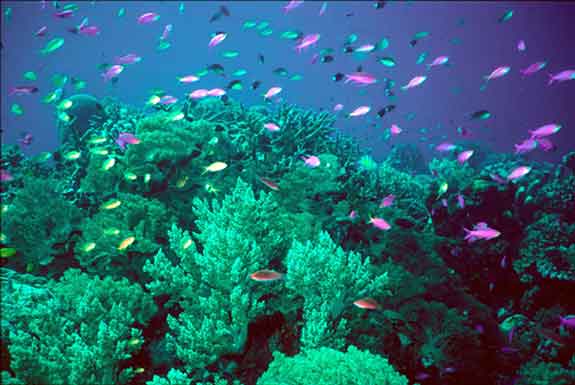
by Deep Green Resistance News Service | Sep 19, 2012 | Biodiversity & Habitat Destruction, Climate Change
By Inter-Press Service
Limiting climate change to two degrees C won’t save most coral reefs, according to new, state-of-the-art research.
About 70 percent of corals are projected to suffer from long-term degradation by 2030 with two degrees C of warming, the first comprehensive global survey reported Sunday in the journal Nature Climate Change.
The planet will get far hotter than two degrees C based on current commitments by countries to reduce their greenhouse gas emissions, mainly from burning oil, gas and coal. Humanity is on course to heat up the atmosphere an average of three and even four degrees C, according to the Climate Action Tracker, an international scientific monitor. Those temperature levels are what most scientists consider “catastrophic”.
Global temperatures have risen an average of about 0.8C so far and already melted much of the Arctic and generated costly extreme weather events around the planet. Keeping that global average increase below two degrees is only a matter of “political will” not technology, said Bill Hare, director of Climate Analytics, one of the partners in the Climate Action Tracker.
If humanity wants to keep at least half of the remaining coral reefs, then global temperatures cannot rise to 1.5C. “Limiting global warming to 2 C is unlikely to save most coral reefs,” the paper reports.
“We must realise what is at stake as global temperatures rise,” said co-author Malte Meinshausen of School of Earth Sciences at the University of Melbourne.
“Countries must be as ambitious as possible in their emission reductions to give corals a chance,” Meinshausen told IPS.
Coral reefs are considered by many to be one of the life-support systems essential for human survival. For more than 2.6 billion people, seafood is the main source of protein. Corals act as the nurseries and habitat for many fish species, and are vital for up to 33 percent of all ocean species, according to the World Conservation Union (IUCN).
Reefs also provide vital shoreline protection from storms. Without reefs, for example, Belize would suffer 240 million dollars in damage from storms, according to one estimate.
This study used the very latest climate models and applied them to growing science about the impacts of rising temperatures and acidification levels projected in the decades to come, said co-author Simon Donner, a marine biologist and climatologist at the University of British Columbia.
The increasing ocean acid conditions appear to be reducing coral’s thermal tolerance, Donner said in an interview. Tropical corals have a narrow water temperature range in which they thrive. When water temperature rises only two or three degrees, they “bleach” or turn white.
Corals can survive this, but if the heat stress persists long enough – weeks instead of days – the corals can die in great numbers, as they did in 1998 when 16 percent of the world’s tropical corals died.
Emissions of greenhouse gases are not only warming the oceans, they have also made them 30 percent more acidic. The oceans and the atmosphere are intimately connected. When CO2 is released into the atmosphere from burning fossil fuels, some of that extra CO2 combines with carbonate ions in seawater, forming carbonic acid. This level of change in ocean chemistry has not happened in millions of years and is beginning to dissolve reefs.
Some corals will undoubtedly survive and some will adapt to the new conditions, although the changes are far more rapid than anything corals have ever experienced, said Donner.
“The bottom line is that humanity will lose the services that corals have provided for thousands of years,” he said.
Even at 1.5 C degrees of warming, only about half corals are likely to survive, the study found. That adds scientific weight to the small island nations’ and other countries’ call for a global target of 1.5 C, Donner said.
Every nation in the world officially agreed to keep global temperature increase below two degrees C at a U.N. climate meeting in Cancun, Mexico in 2010. An alliance of small islands and African countries had lobbied for the global target of less than 1.5 C due to the damages they are expected to suffer if temperatures rise above that mark.
Emissions must begin to decline this decade for either target so it is pointless to debate these targets right now, says Meinshausen. Once emissions are in significant decline, then how fast and how deep those cuts will have relevance for the final target, he said.
“I fear we’re going to miss our only chance to peak emissions this decade,” he said.
Read more from Inter-Press Service: http://www.ipsnews.net/2012/09/deeper-co2-cuts-needed-to-save-corals/
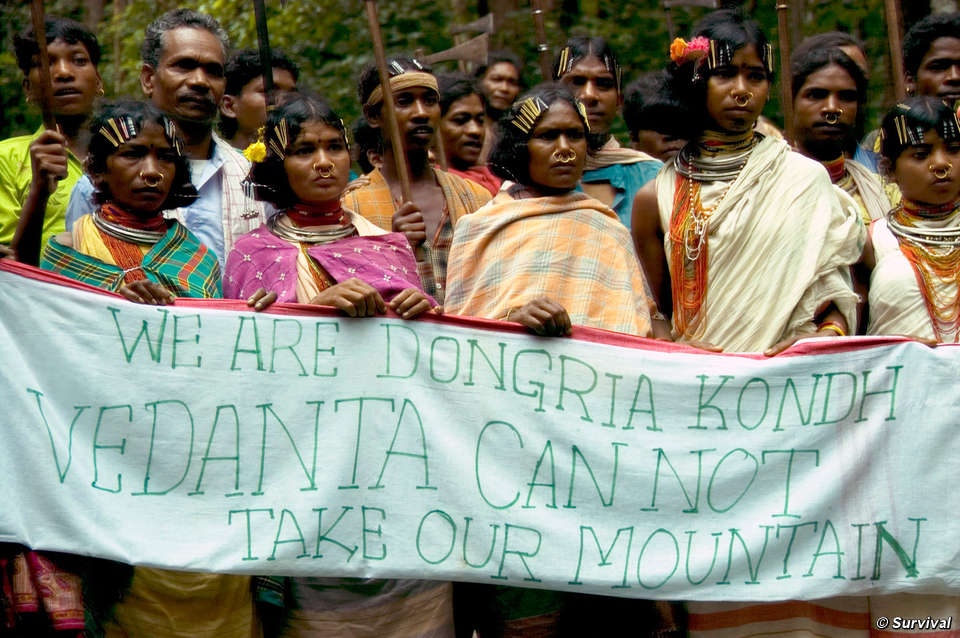
by Deep Green Resistance News Service | Sep 18, 2012 | Colonialism & Conquest, Indigenous Autonomy, Lobbying, Mining & Drilling
By Survival International
Supporters of India’s Dongria Kondh tribe are celebrating after controversial British mining company Vedanta Resources declared it will close its bauxite refinery in the state of Orissa, this December.
The news is a major breakthrough for the tribe, who have fought a David and Goliath battle against Vedanta’s plans to extract bauxite from their land.
Dongria leader, Lodu Sikaka, said today, ‘We will be happy if the company leaves. If the refinery is there, they will keep trying to take our mountain, if not today, then tomorrow, or two years, 10 years from now.’
The Lanjigarh refinery sits at the base of the Dongria Kondh’s Niyamgiri Hills, which are home to the 8,000-strong tribe, and the seat of their god Niyam Raja. The company has spent more than one billion US dollars expanding the site without securing all the required clearances, as well as knowing it was unable to source enough bauxite to run the refinery at capacity.
Vedanta has now blamed the closure on a ‘depleting stock position of bauxite’. But, there are concerns the company’s announcement is intended to pressure the government into allowing it to mine the Niyamgiri Hills. The issue has returned to India’s Supreme Court, but the case is currently adjourned.
Opposition to Vedanta’s push to mine the mountains has embroiled the company in a near decade-long dispute, and forced the Lanjigarh refinery to be run with bauxite from different mines across India. A Vedanta spokesman claimed this has cost the company half a billion dollars.
Survival International’s Director Stephen Corry said today, ‘When we started our campaign for the Dongria Kondh, we were repeatedly told it was a hopeless case and the mine would be built. It hasn’t been. The infrastructure is rusting away and now Vedanta says it will shelve its refinery. This is a fantastic vindication of the tribal people’s determination to keep the lands which are rightfully theirs, and the pressure brought to bear by thousands of their and our supporters around the world. Public pressure is the only thing which can save tribal peoples in the long-term, and it works.’
From Survival International: http://www.survivalinternational.org/news/8670
by Deep Green Resistance News Service | Sep 17, 2012 | Climate Change
By John Vidal / The Guardian
One of the world’s leading ice experts has predicted the final collapse of Arctic sea ice in summer months within four years.
In what he calls a “global disaster” now unfolding in northern latitudes as the sea area that freezes and melts each year shrinks to its lowest extent ever recorded, Prof Peter Wadhams of Cambridge University calls for “urgent” consideration of new ideas to reduce global temperatures.
In an email to the Guardian he says: “Climate change is no longer something we can aim to do something about in a few decades’ time, and that we must not only urgently reduce CO2 emissions but must urgently examine other ways of slowing global warming, such as the various geoengineering ideas that have been put forward.”
These include reflecting the sun’s rays back into space, making clouds whiter and seeding the ocean with minerals to absorb more CO2.
Wadhams has spent many years collecting ice thickness data from submarines passing below the arctic ocean. He predicted the imminent break-up of sea ice in summer months in 2007, when the previous lowest extent of 4.17 million square kilometres was set. This year, it has unexpectedly plunged a further 500,000 sq km to less than 3.5m sq km. “I have been predicting [the collapse of sea ice in summer months] for many years. The main cause is simply global warming: as the climate has warmed there has been less ice growth during the winter and more ice melt during the summer.
“At first this didn’t [get] noticed; the summer ice limits slowly shrank back, at a rate which suggested that the ice would last another 50 years or so. But in the end the summer melt overtook the winter growth such that the entire ice sheet melts or breaks up during the summer months.
“This collapse, I predicted would occur in 2015-16 at which time the summer Arctic (August to September) would become ice-free. The final collapse towards that state is now happening and will probably be complete by those dates”.
Wadhams says the implications are “terrible”. “The positives are increased possibility of Arctic transport, increased access to Arctic offshore oil and gas resources. The main negative is an acceleration of global warming.”
“As the sea ice retreats in summer the ocean warms up (to 7C in 2011) and this warms the seabed too. The continental shelves of the Arctic are composed of offshore permafrost, frozen sediment left over from the last ice age. As the water warms the permafrost melts and releases huge quantities of trapped methane, a very powerful greenhouse gas so this will give a big boost to global warming.”
From The Guardian: http://www.guardian.co.uk/environment/2012/sep/17/arctic-collapse-sea-ice
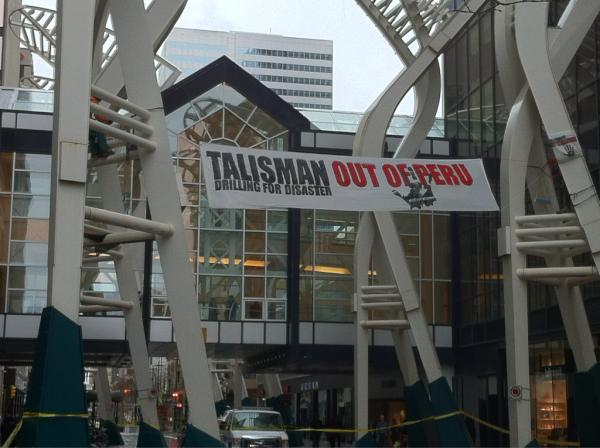
by Deep Green Resistance News Service | Sep 14, 2012 | Colonialism & Conquest, Indigenous Autonomy, Mining & Drilling
By Amazon Watch
Today Talisman Energy (TLM) announced its decision to cease oil exploration activities in the Peruvian Amazon and to exit the country upon completion of ongoing commercial transactions.
“We have fought long and hard against Talisman’s drilling in our territory because of the negative environmental and social impacts we have seen from oil drilling around the world,” said Peas Peas Ayui, President of the National Achuar Federation of Peru (FENAP). “Now that Talisman is leaving we can focus on achieving our own vision for development and leave a healthy territory for future generations.”
Talisman is the fifth oil company to withdraw from controversial Block 64, located in the heart of indigenous Achuar territory in a remote and bio diverse region of the Amazon rainforest. Talisman has been exploring in Peru since 2004 and has come under increased pressure by human rights groups and shareholders for operating without Achuar consent.
“Talisman has had to face up to what the Achuar told them when they first invested in Block 64: The company cannot drill without the consent of the Achuar people,” said Gregor MacLennan, Peru Program Coordinator at Amazon Watch. “Talisman’s exit sends a clear message to the oil industry: Trampling indigenous rights in the rush to exploit marginal oil reserves in the Amazon rainforest is not an option.”
Despite Talisman’s claim of attaining local support from communities and signing good neighbor agreements with 66 communities downriver from their operations, the company never had the consent of the majority of communities living within Block 64. Talisman first invested in Peru one year after leaving Sudan and became sole operator in 2007, shortly after John Manzoni’s appointment as CEO. Manzoni was replaced by ex-TransCanada CEO Hans Kvisle on Monday this week.
“We are the owners and the original people of this land,” said Peas Ayui. “No outside person or company may enter our territory by force, without consultation and without asking us. We have been fighting against oil development on our land for 17 years and we maintain the same vision to protect our territory and resources for future generations. Let this be a clear message to all oil, mining and logging companies: we will never offer up our natural wealth so that they can extract our resources and contaminate our land.”
Block 64 is just one of several new efforts to extract oil from the headwaters of the Amazon in Northern Peru and Southern Ecuador, among the most bio diverse places on earth. Anglo-French company Perenco was recently awarded a production license to operate in Block 67 in Peru despite a legal case against them for drilling in isolated peoples’ territory. ConocoPhilliips has faced mass protests in Iquitos, Peru over plans to drill wells in a protected area in the Nanay river basin east of Block 64. In Ecuador, the government plans to auction new oil blocks on the Peruvian border despite strong indigenous opposition. The Kichwa community of Sarayaku recently won a case in the Inter-American Court of Human Rights against the Ecuadorian government for signing an oil contract without their consent or consultation.
From Amazon Watch: http://amazonwatch.org/news/2012/0913-talisman-energy-withdraws-from-peruvian-amazon
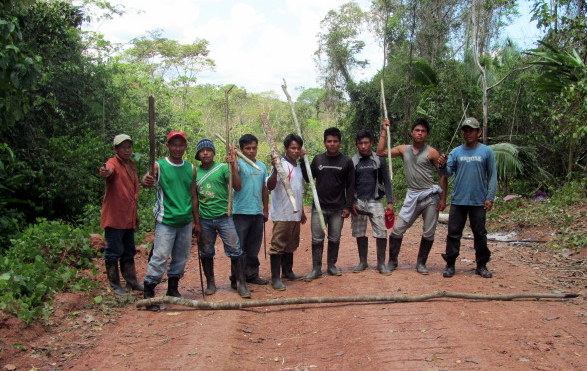
by Deep Green Resistance News Service | Sep 10, 2012 | Indigenous Autonomy, Mining & Drilling, Obstruction & Occupation, Toxification
By Ronald Suarez, Network of Peruvian Indigenous Communicators, Ucayali
Over 400 villagers in the Native Community of Canan de Cachiaco in the Ucayali region of the Peruvian Amazon have taken control of nine oil wells, belonging to oil company, Maple Gas, in oil lot 31B.
Community members took over the oil wells on September 2nd, and continue to hold them as a result of 37 years of oil contamination in their territory by the company.
The community leader, Basilio Rodriguez Venancio, said the action was made necessary because the company did not consider the environmental impact assessment carried out by an independent consultant.
The community is demanding that the company pay them compensation for the use of their lands and for the environmental damage they have suffered for 37 years. Such damage includes the contamination of their rivers, their only source of drinking water, and the contamination of their soils due to the company’s use of chemicals and heavy minerals, which the population says has significantly affected the productivity of their land.
Several community members testified that they have become sick due to the company’s negligence and contamination of their drinking water. There have been several instances in the past years of cancer and ¨unknown deaths¨ that the community attributes to company abuses.
The community awaits the arrival of state representatives from the Ministry of Energy and Mines and Ministry of Environment, scheduled for Thursday, September 13th, to resolve this conflict.
Meanwhile the villagers are still stationed in the camp until authorities settle their claims.
From Alianza Arkana





